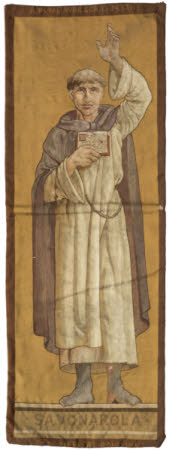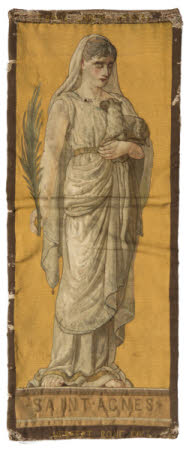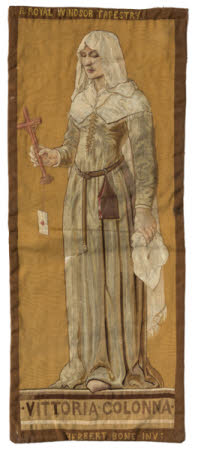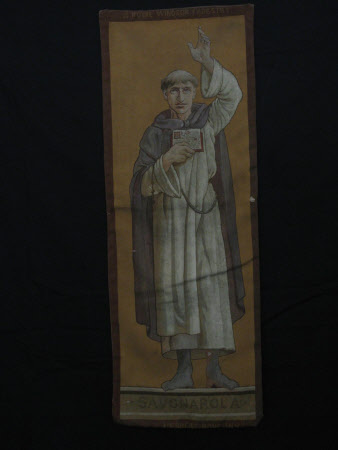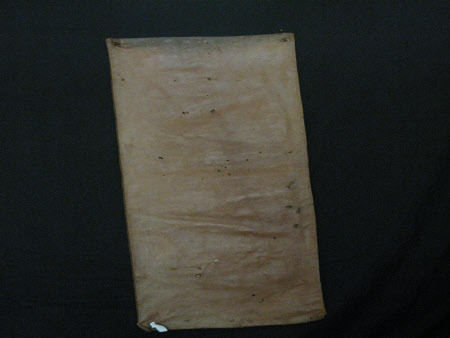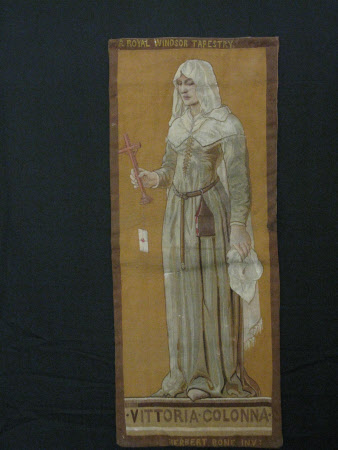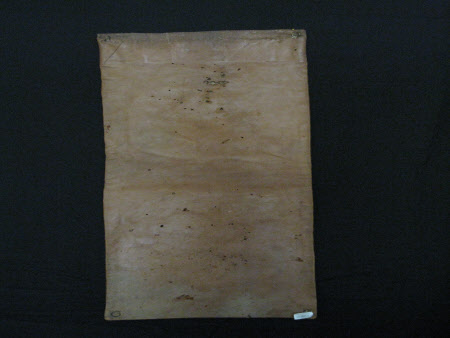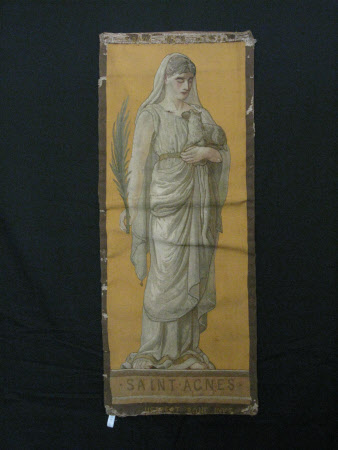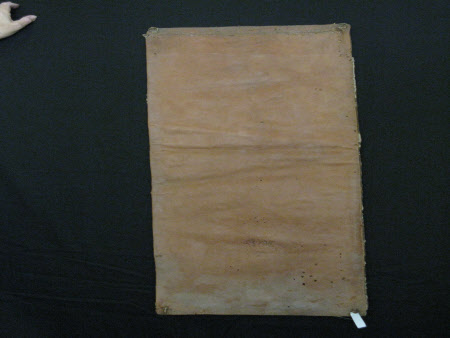Savonarola
Royal Windsor Tapestry Manufactory
Category
Tapestries
Date
circa 1881
Materials
Tapestry, wool, silk and cotton, 10 warps per cm
Measurements
990 mm (H); 360 mm (W)
Place of origin
Old Windsor
Order this imageCollection
Tyntesfield, North Somerset
NT 18455
Summary
Tapestry, wool and silk, 10 warps per cm, Savonarola from a set of three Salviati Mosaic Tapestries, Windsor Tapestry Manufactory after a design by Herbert Bone, c. 1881. The single figure of Savonarola stands holding a book against his chest and raising one arm in a preaching gesture. His hair is tonsured and he wears a grey cloak over a white habit. He stands on a ledge inscribed with his name and is set against a plain dull orange background. There is a dull red galloon around all four sides of the tapestry inscribed ‘ROYAL WINDSOR TAPESTRY’ at the top and ‘HERBERT BONE INVT.’ at the bottom. The tapestry is lined with leather.
Full description
The tapestry represents the preacher and reformer Girolamo Savonarola (1452-1498), a Dominican friar who brought about the expulsion of the Medici and the establishment of a republic in Florence, and instituted a programme of moral reform in the city, but was later burned at the stake as a heretic. ‘Savonarola’ is one of three tapestries at Tyntesfield from a series designed by Herbert Bone. The others represent ‘Saint Agnes’ (at Tyntesfield, no. 18457), ‘Richard Coeur de Lion’, ‘Jeanne d’Arc’, ‘Cimabue’ and ‘Vittoria Colonna’ (also at Tyntesfield, no. 18456). This unlikely collection of characters seems to represent art, faith and patriotism in the Medieval and renaissance periods. The figures were originally designed by Herbert Bone (1853-1931), whose signature is woven into the bottom of each panel, as the basis for mosaics by Antonio Salviati (1816-1890). The mosaics were never executed, and Cullingham suggests that this may be why Bone decided to use the designs for tapestries instead. Salviati, a Venetian lawyer who helped revive the techniques of glass making and mosaic in the mid nineteenth century, had earlier made mosaics for the chapel at Tyntesfield and carried out a number of high-profile projects in England including for Saint Paul’s Cathedral and the Albert Memorial (Miller 2003, p. 126; Cullingham 1979, p. 71). Some of Bone’s drawings for ‘Salviati Mosaic’ series are in the Royal Library at Windsor, part of a large collection of drawings and correspondence by the artist relating to his work for the Windsor manufactory (Millar 1995, vol. 1, pp. 98-9). The designs were made in 1881, so the tapestries were probably woven shortly afterwards. The three tapestries were made at the Royal Windsor Tapestry Manufactory, whose signature is woven into the upper galloon of each tapestry. The manufactory was founded in Old Windsor in 1876 by Henri C Henry, artistic adviser to the furniture company Gillow & Co., and Marcel Brignolas, who came to England with a group of French weavers from the ancient tapestry-producing town of Aubusson. Prince Leopold, Queen Victoria’s youngest son, supported the manufactory and became its president, while the Queen herself made several visits and in 1880 consented to its being termed ‘Royal’. The enterprise began with great success when a series of the ‘Merrie Wives of Windsor’ sent to the 1878 Paris Exhibition won a gold medal. Despite this promising start, and a number of royal commissions, by the time Prince Leopold died in 1884 the manufactory was already in severe financial difficulties. Further investment and commissions were sought and a number of important projects were undertaken in the later 1880s, but in 1890 the manufactory was forced to close. The tapestries were commissioned by Antony Gibbs (1841-1907), who later commissioned two larger tapestries of the ‘Story of King Alfred’ from the Windsor manufactory, which are also in the National Trust’s collection at Tyntesfield (no. 33551). In choosing to commission tapestries from the Royal Windsor Manufactory Antony Gibbs was probably influenced by his cousin Henry Hucks Gibbs, who was one of the guarantors of the workshop and also an important patron (Miller 2003, p. 126; Cullingham 1979, p. 4). Examples of ‘Saint Agnes’, ‘Savonarola’ and ‘Richard Coeur de Lion’ were exhibited at the Vigo Sternberg galleries, 1975. An example of ‘Richard Coeur de Lion’ was in the collection of Gordon Cullingham in 1979. A screen including ‘Jeanne d’Arc’, ‘Cimabue’ and ‘Saint Agnes’ was exhibited at the Chicago World’s Fair, 1893 (Cullingham 1979, pp. 70-72, 75-76). The three panels at Tyntesfield were originally pinned to a wooden screen in the chapel. (Helen Wyld, 2013)
Provenance
Acquired by Antony Gibbs (1841-1907) for Tyntesfield, c. 1881; thence by descent to Richard Gibbs, 2nd Baron Wraxall (1928-2001); purchased by the National Trust from the estate of Lord Wraxall with the assistance of the NHMF and donations from members and supporters.
Marks and inscriptions
In upper galloon: ROYAL WINDSOR TAPESTRY, preceded by the monogram of Marcel Brignolas Beneath figure’s feet: SAVONAROLA In lower galloon: HERBERT BONE INVT.
Makers and roles
Royal Windsor Tapestry Manufactory , workshop Herbert Alfred Bone (1853/4 - London 1931/2) , designer
References
Miller, 2003 James Miller, Fertile Fortune The Story of Tyntesfield, The National Trust 2003 Millar, 1995: Delia Millar, The Victorian Watercolours and Drawings in the Collection of Her Majesty the Queen, 2 vols., London 1995 Cullingham, 1979: Gordon Graham Cullingham, The Royal Windsor Tapestry Manufactory, 1876-1890: an illustrated handlist of tapestries woven at the Old Windsor works, The Royal Borough of Windsor and Maidenhead 1979 Bone, 1881: Herbert Bone, The Windsor Tapestries at Aldenham House, Herts., privately printed, London 1881 Bone, 1888: Herbert Bone, The Windsor Tapestries at Tyntesfield, privately printed, London 1888
